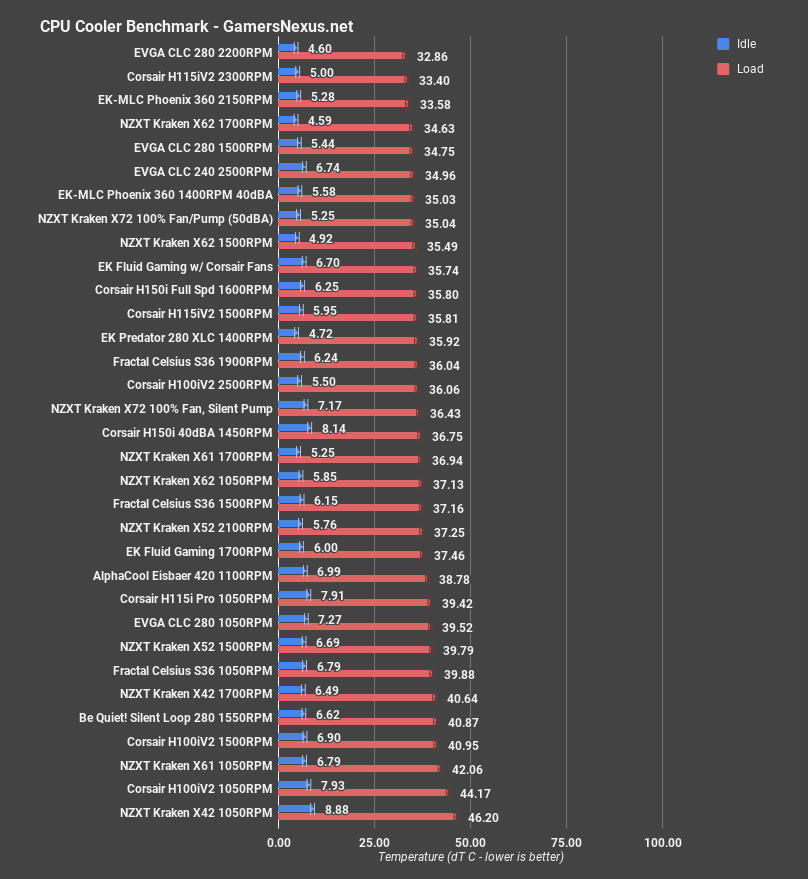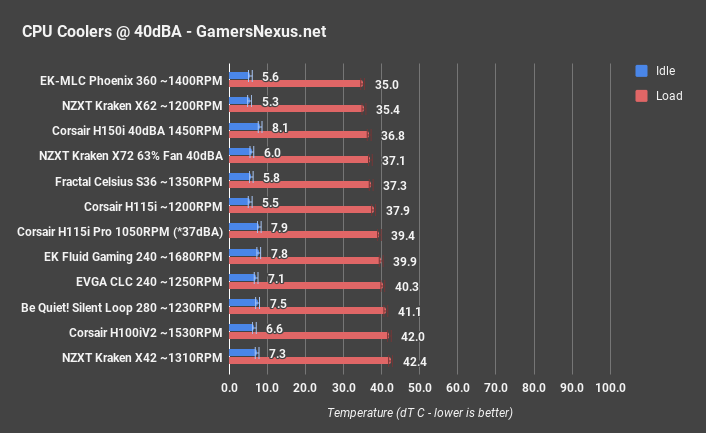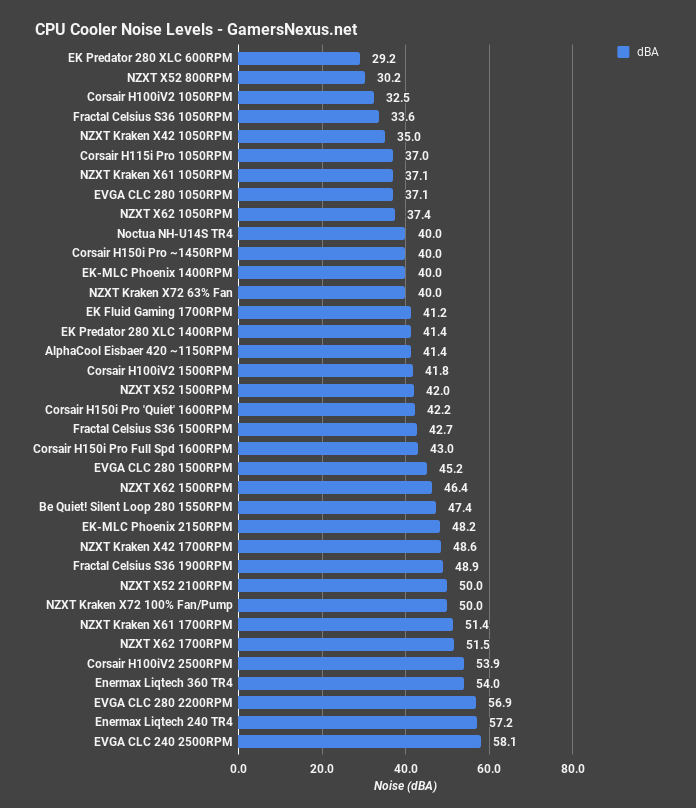NZXT’s Kraken X72 closed-loop liquid cooler is another in the XX2 series, following the 280mm X62 that we previously reviewed. The X72 is a 360mm cooler, putting it in more direct competition with the Corsair H150i Pro (the first to feature a 6th-gen pump) and Fractal S36, and indirect competition – in performance only – with the EVGA CLC 280.
NZXT’s X72 costs $200, making it one of the most expensive CLCs on the market. The Floe 360 lands at around $184, the EK Phoenix 360 – a semi-open solution – is the only one that lands significantly higher. The X72 still uses the same pump design as when we tore-down the X42, running Asetek’s 5th Gen pump and a custom, NZXT-designed PCB for RGB lighting effects. Functionally, 5th Gen has proven to be marginally superior – technically – to its 6th Gen for outright cooling performance. We’re talking nearly margins of error. The newest generation is presently only used on Corsair’s H150i and H115i Pro products, as Corsair largely dictated what went into the 6th generation. Major differences are made-up by the metal impeller, similar to the one used by Dynatron in old Antec Kuhler products, rather than a 3-prong plastic impeller. These don’t perform differently in terms of thermals, but there should be reduced susceptibility to heated liquid, and theoretically reduced hotspots as a result of the new 6th Generation design. That doesn’t manifest in outright performance, but might manifest in endurance. We won’t know for a few years, realistically.
Our primary tests for the NZXT Kraken X72 review and benchmark include the following:
- 100% fan / 100% pump
- 100% fan / silent pump
- 63% fan (40dBA)
CPU Cooler Test Methodology
CPU cooler testing is conducted using the bench defined below. We use a bench that is more carefully crafted for noise performance, opting for a passively cooled PSU and 23% RPM 980 Ti blower fan for very low system noise.
We strongly believe that our thermal testing methodology is among the best on this side of the tech-media industry. We've validated our testing methodology with thermal chambers and have proven near-perfect accuracy of results.
Conducting thermal tests requires careful measurement of temperatures in the surrounding environment. We control for ambient by constantly measuring temperatures with K-Type thermocouples and infrared readers. Two K-Type thermocouples are deployed around the test bench: One (T1) above the bench, out of airflow channels, and one (T2) approximately 2-3" in front of the cooler's intake fan. These two data points are averaged in a spreadsheet, creating a T3 value that is subtracted second-to-second from our AIDA64 logging of the CPU cores.
All six CPU cores are totaled and averaged second-to-second. The delta value is created by subtracting corresponding ambient readings (T3) from the average CPU core temperature. We then produce charts using a Delta T(emperature) over Ambient value. AIDA64 is used for logging thermals of silicon components, including the CPU and GPU diodes. We additionally log core utilization and frequencies to ensure all components are firing as expected. Voltage levels are measured in addition to fan speeds, frequencies, and thermals.
The cores are kept locked to 3.8GHz (x38 multiplier). VCore voltage is locked to 1.141v for the CPU. C-States are disabled, as is all other power saving. The frequency is locked without any interference from boost or throttle functions. This is to ensure that the CPU does not undergo any unexpected/uncontrollable power saving or boost states during testing, and ensures that the test platform remains identical from one device to the next.
Fan speeds are manually controlled unless otherwise defined. For liquid coolers, pumps are set to 100% speed unless otherwise defined.
No open bench fans are used for these CPU cooler tests. Only fans which are provided with the cooler are used.
| GN Test Bench 2015 | Name | Courtesy Of | Cost |
| Video Card | GTX 980 Ti Reference 23% RPM | NVIDIA | EOL |
| CPU | Intel i7-5930K CPU @ 3.8GHz | iBUYPOWER | $580 |
| Memory | Corsair Vengeance 32GB 2666MHz | Corsair | $175 |
| Motherboard | EVGA X99 Classified | GamersNexus | $365 |
| Power Supply | Enermax DigiFANLESS | Enermax | $250 |
| SSD | HyperX Savage SSD | Kingston Tech. | $130 |
| Case | Top Deck Tech Station | GamersNexus | $250 |
| CPU Cooler | This is what we're testing! | - | - |
We use an AMPROBE multi-diode thermocouple reader to log ambient actively. This ambient measurement is used to monitor fluctuations and is subtracted from absolute GPU diode readings to produce a delta value. For these tests, we configured the thermocouple reader's logging interval to 1s, matching the logging interval of GPU-Z and AIDA64. Data is calculated using a custom, in-house spreadsheet and software solution.
Our test starts with a 180s idle period to gauge non-gaming performance. A script automatically triggers the beginning of a CPU-intensive benchmark running Prime95 LFFTs. Because we use an in-house script, we are able to perfectly execute and align our tests between passes.
CPU Cooler Benchmark – Best “AIO” Closed-Loop Liquid Coolers
Tested at flat-out speeds, the Kraken X72 cooler maintains a steady state load temperature of 35 degrees Celsius over ambient, roughly equivalent to the Corsair H150i Pro at max speeds of 1600RPM, measuring at 35.8 degrees over ambient. The difference is within margin of error. The EK Phoenix 360 is an expandable loop with more open loop tendencies than closed-loop tendencies, and benefits from additional headroom at higher RPMs of 2150. The EK Phoenix does about 33.6 degrees at peak performance, using fans with 150RPM higher speed and an overall bigger cooler and block. Compared more fairly versus other 360mm coolers, the Kraken X72 is right around the H150i Pro and the Fractal S36 at 1900RPM, which is about 100RPM slower than the X72’s fans.
Running the X72 with 100% fan speeds and a silent pump setting, we land at 36.4 degrees over ambient. This marks it as roughly tied with the H150i Pro at 40dBA and H100iV2 at max fan RPMs – a significantly louder cooler, but one which performs equivalently when slowing the X72 pump.
Noise-Normalized Performance
Noise-normalized testing is done to equal the playing field of the coolers, setting all of them to the same total system noise level of 40dBA. This allows us to test overall efficiency and efficacy of cooler and fan design.
For noise-normalized cooling performance at 40dBA total system noise, the Kraken X72 at 63% fan speeds measured at 37.1C over ambient. This plants us right between the H150i Pro 360mm cooler and Fractal S36 360mm cooler. These three numbers are all within margin of error of one another. There is no significant difference between coolers within +/- 1 degree of the result, and the X62 is also functionally equivalent when noise-normalized. Keep in mind that pump speeds are somewhat variable, with a 10% variance, contributing to some unit-to-unit differences, and the fan size of these coolers is also different.
NZXT’s X72 performance is about in-line with other high-end coolers. It is outdone at noise normalized performance by the EK MLC Phoenix 360, but that’s a very expensive cooling solution with semi-open loop possibilities.
Acoustic Performance
For noise levels, the stock Kraken X72 with full fan and pump speeds measures at 50dBA, the same as the X52 – a 240mm cooler – with max fan speeds, and also not far from the S36. 63% fan speeds hit 40dBA for this one. The silent pump setting doesn’t do much to reduce noise, but that’s because we had no issues with this pump making noise to begin with. Some Asetek pumps can be whiney, but this particular unit performed well and did not have meaningful pump noise.
Conclusion: Is the X72 Worth It?
There’s nothing wrong with the X72. It’s a bit pricey, yes, but it is functionally an OK product. We don’t have a firm, mechanical or technical reason to recommend against the X72. If it weren’t so expensive, we’d recommend for it. Ultimately, you’re left with a huge amount of closed-loop coolers that perform similarly to each other – close enough to be within margins, in the case of many 280s and 360s – and so choices have to be made based on looks and sale prices. If going for the absolute best deal for the dollar, EVGA’s CLC 280 is presently on an unbeatable (and seemingly indefinite) sale. If going for the best looks, NZXT does have one of the better-designed PCBs and RGB LED illumination features, and so finds its cost justified in that department. Corsair strikes a middle-ground between these two – it is not any meaningfully different in performance, has many of the RGB features, but sits at a middle-ground for price.
As much as we hate wishy-washy conclusions, this one really does come down to preference. For raw performance, don’t buy the X72 – it’s not meaningfully advantaged over its neighbors. For looks, NZXT has a good position in that aspect, and would be easily recommended for buyers with a lot of money. The X62 is every bit as good for cooling, assuming your case fits a 280mm CLC, and still has the same RGB LED features. That’d be a worthy alternative for a few bucks cheaper.
Editorial, Testing: Steve Burke
Video: Andrew Coleman


